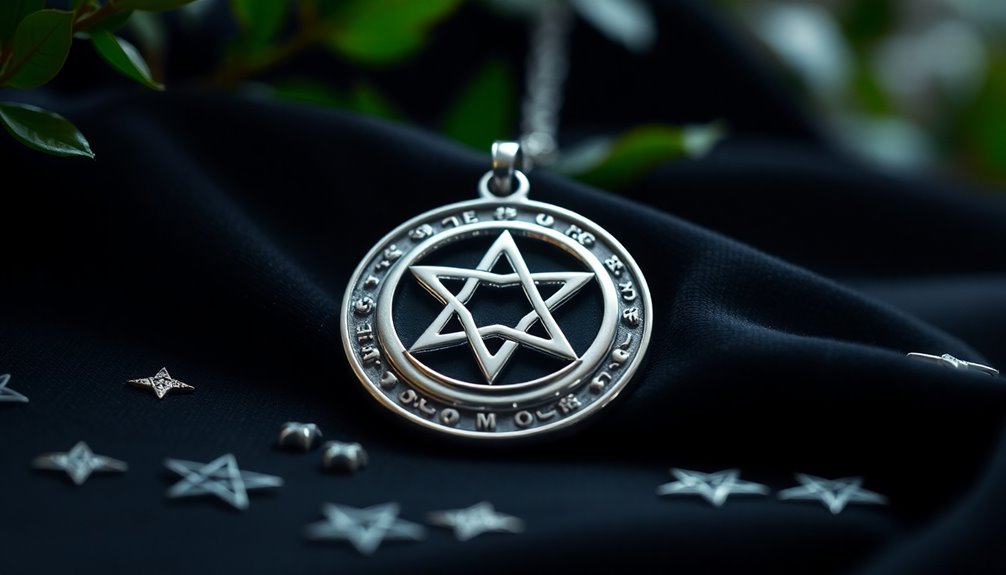The pentagram, a five-pointed star, holds a rich tapestry of meaning across cultures. It symbolizes protection, harmony, and the five elements: earth, air, fire, water, and spirit. In ancient times, it was linked to divine guidance and later represented the five wounds of Christ. Misunderstandings arose around its occult associations, often overshadowing its original protective nature. Today, it's embraced in various spiritual practices, including Wicca, as a symbol of unity and balance. As you explore further, you'll uncover how this powerful symbol has transformed through time and continues to resonate in contemporary culture.
Key Takeaways
- The pentagram symbolizes protection and harmony, originating from ancient cultures and representing balance among the five elements: earth, air, fire, water, and spirit.
- In religious contexts, it reflects the five wounds of Christ, illustrating themes of sacrifice, redemption, and God's eternal nature.
- Alchemically, it embodies transformation and unity, linking spiritual and material realms through its representation of the classical elements.
- Misunderstandings often associate the pentagram with occultism, although historically it served as a protective symbol across various cultures.
- In modern practices, the pentagram is reclaimed by neopagan traditions as a symbol of unity, collective purpose, and energy alignment during rituals.
Introduction
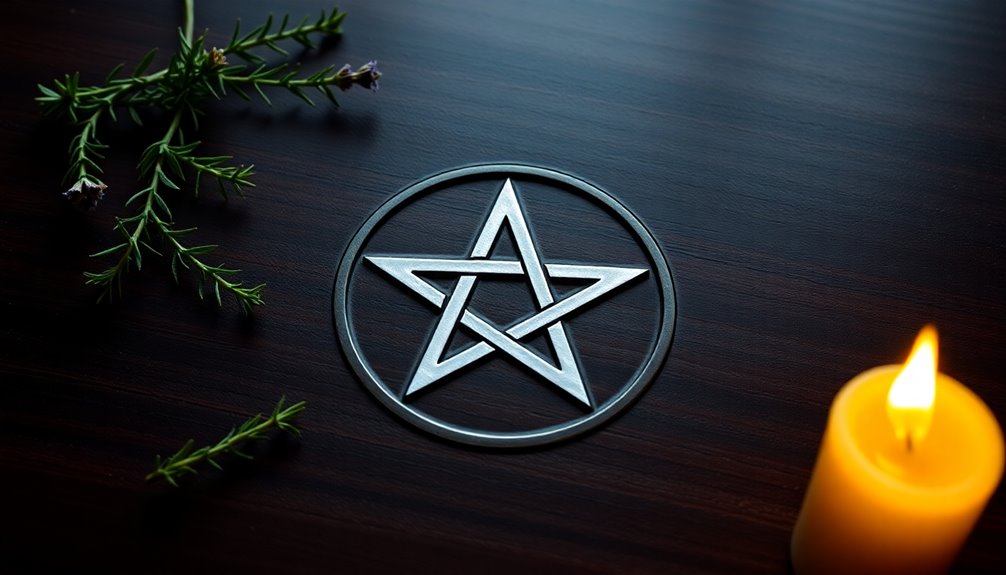
The pentagram, a captivating five-pointed star, has fascinated people for centuries with its rich tapestry of meanings and associations. This symbol, formed by connecting the non-adjacent vertices of a regular pentagon, holds significant weight in both ancient cultures and modern interpretations. Each of its five points represents the elements: earth, air, fire, water, and spirit, illustrating the interconnectedness of all things.
In ancient cultures, the pentagram symbolized protection and harmony, serving as a powerful emblem of spiritual balance. When you see an upright pentagram, it's often connected to positive meanings, embodying safety and a sense of wholeness. In contrast, the inverted pentagram carries more controversial connotations, frequently linked to occult practices and darker themes.
The term "pentagram" itself derives from the Greek word πεντάγραμμον (pentagrammon), meaning "five lines," which highlights its geometric elegance.
The pentagram's mathematical properties, including its connection to the golden ratio, enhance its aesthetic allure, making it a beloved choice in art and design. Understanding these layers of meaning can deepen your appreciation for this iconic symbol.
Biblical Symbolism of Pentagram
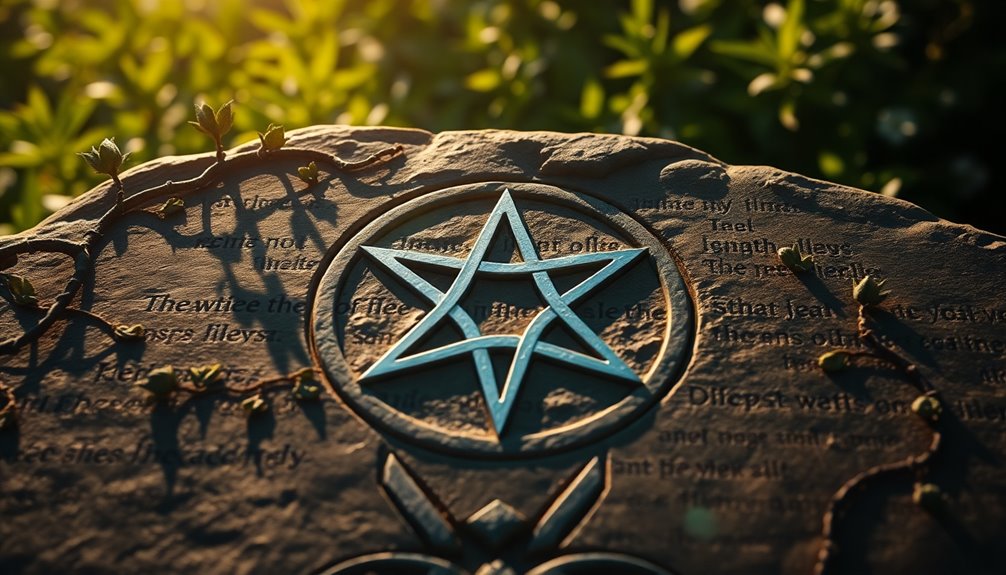
When exploring the biblical symbolism of the pentagram, you'll find it reflects significant themes, particularly in relation to Jesus Christ's sacrifice and God's eternal nature.
Primary and secondary Bible references illuminate its meanings, revealing a complex history that intertwines with early Christian beliefs.
Understanding these references can help clarify the pentagram's role in both faith and culture.
Primary Bible References
In exploring the biblical symbolism of the pentagram, you'll find that it isn't directly mentioned in scripture, yet its associations carry significant meaning. This five-pointed star often relates to the five wounds of Christ, symbolizing His sacrifice and the redemption offered to humanity.
In Christian symbolism, the points can also represent the five senses, reminding you that experiencing the world is a gift from God. Additionally, some interpretations view the pentagram as a protective symbol, paralleling the concept of divine protection found throughout the Bible. Just as angels are depicted as guardians, the pentagram can serve as a reminder of spiritual safeguarding.
Furthermore, the continuous line forming the pentagram can symbolize eternity, reflecting God's infinite nature, akin to the Alpha and Omega symbolism present in Revelation 22:13.
Finally, the pentagram's geometric properties, particularly its connection to the golden ratio, mirror the divine order and harmony emphasized in biblical teachings. Together, these interpretations position the pentagram as a rich religious symbol, intertwining faith, protection, and the essence of existence within the Christian context.
Secondary Bible References
Throughout biblical symbolism, the pentagram often emerges as a multifaceted emblem, rich with meaning beyond its surface. While it's not explicitly mentioned in the Bible, its associations with early Christianity are significant. The five points of the pentagram can represent the five wounds of Christ, reflecting themes of sacrifice and redemption. This connection highlights the divine grace and goodness tied to the number five, emphasizing God's mercy.
Furthermore, the continuous line of the pentagram symbolizes the Alpha and Omega, representing God's eternal nature as noted in Revelation 22:13. Its geometric perfection and alignment with the golden ratio resonate with biblical themes of divine order and harmony in creation, showcasing a deeper spiritual significance.
Ancient Christian mysticism often used the pentagram as a symbol of protection, embodying the idea of safeguarding the faithful against evil. This aligns with the spiritual warfare concepts found in Ephesians 6:12, where believers are reminded of the ongoing battle against malevolent forces.
Thus, the pentagram serves as a powerful emblem of divine protection and spiritual strength within Christian contexts.
Medieval Alchemical Symbolism

The pentagram, a star-shaped figure often recognized for its mystical connotations, plays a significant role in medieval alchemical symbolism. In this context, the pentagram represents the five classical elements: earth, air, fire, water, and spirit, emphasizing the balance and unity among them.
Alchemists deeply valued this symbol, often using it as a protective symbol to ward off negative energies during their experiments and spiritual practices.
The pentagram's connection to the philosopher's stone is particularly noteworthy. This legendary substance symbolizes the transformation of base materials into noble ones, reflecting the alchemical quest for enlightenment and mastery over the physical world.
In alchemical texts, you might find the pentagram appearing alongside other symbols like the ouroboros, illustrating the cyclical nature of life and the interconnectedness of all elements.
This integration of mysticism and science during the medieval period showcases how alchemists sought to bridge the gap between the spiritual and material realms.
The pentagram, thus, serves as a powerful emblem of their endeavors, embodying the quest for unity, protection, and the profound transformations that lie at the heart of alchemical practices.
Symbolic Meanings Across Cultures

Exploring the pentagram's significance reveals its rich tapestry of meanings across various cultures.
In Christianity, the pentagram acts as a religious symbol representing the five wounds of Jesus Christ, highlighting the connection between the divine and humanity.
Pythagorean philosophy emphasizes its five points as reflections of the five elements: earth, air, fire, water, and spirit, showcasing the harmony of the universe.
Wicca embraces the upright pentagram encircled by a circle, a powerful emblem of protection and unity, symbolizing the balance of elemental forces.
Similarly, ancient Babylonian culture linked the pentagram to various deities, often associating it with protection and divine guidance.
In Icelandic folklore, this symbol serves as a safeguard against malevolent forces, illustrating its diverse cultural interpretations.
Across these traditions, the pentagram embodies a multifaceted significance, merging the themes of protection, unity, and the interplay of elemental forces.
Misunderstanding Its Occult Origins
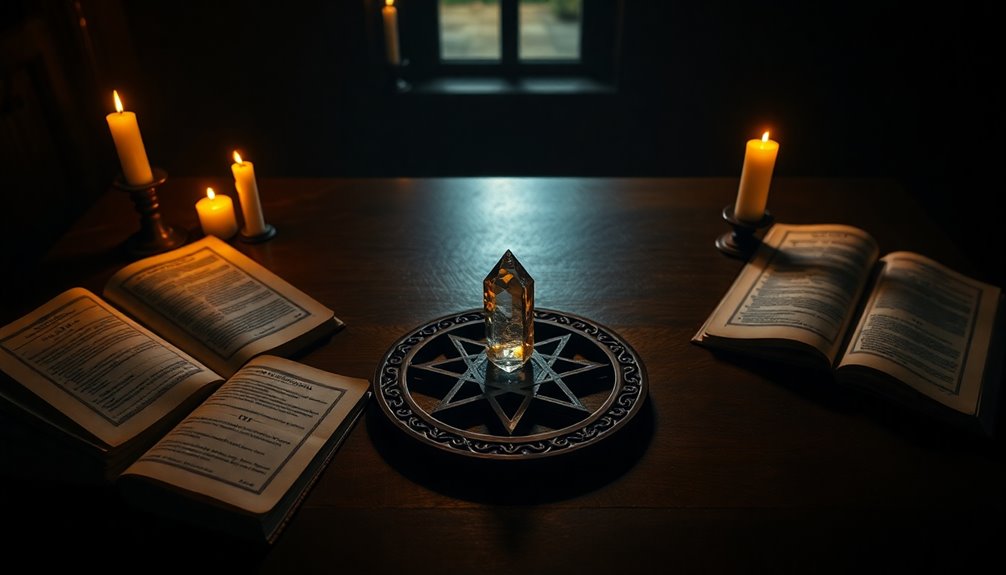
You might be surprised to learn that the pentagram's association with occultism isn't as straightforward as it seems.
Many misconceptions stem from a lack of understanding of its rich historical context, which includes its use in ancient cultures and Christian symbolism.
Debunking Common Misconceptions
Many people often get tangled up in the misconceptions surrounding the pentagram, particularly its alleged occult origins. You might've heard it described as a symbol of evil, primarily due to its association with Satanism. However, the pentagram itself contains no inherent power; its meaning is derived from the context in which it's used.
In ancient times, it served as a protective symbol, representing harmony, especially in Pythagoreanism. The inverted pentagram, often linked to negative connotations, was historically used in various cultures to symbolize the physical over the spiritual, not just as a representation of evil.
It's crucial to understand that many contemporary fears stem from misunderstandings propagated by modern media, overshadowing the pentagram's original meanings of protection and balance.
Additionally, awareness of the pentagram's rich historical context, including its use in ancient Mesopotamian cultures and medieval Christian symbolism, can help you navigate these misconceptions.
Ultimately, the pentagram is a diverse symbol, not limited to religious or occult interpretations, but rich in meaning across various traditions.
Historical Context Misinterpretations
Misunderstood throughout history, the pentagram's origins tell a different story than the one often portrayed in popular culture. You might be surprised to learn that the pentagram has ancient origins, first appearing in Mesopotamian artifacts as a symbol linked to deities.
During the Middle Ages, it served as a protective symbol representing the five wounds of Christ, contrasting sharply with its later misinterpretations as an evil emblem.
Many misunderstandings stem from 19th-century occult revival movements that emphasized the inverted pentagram, often associating it with satanism. This shift contributed to the negative connotations that haunt the pentagram today.
However, the significance of the pentagram varies widely across cultures. Many ancient civilizations embraced it as a symbol of protection and spiritual balance, highlighting its original intent.
Understanding the historical context of the pentagram is crucial for unraveling these misinterpretations. The pentagram's meanings have evolved over time, leading to a distortion of its original protective and spiritual symbolism.
Ritualistic Use in Meditation
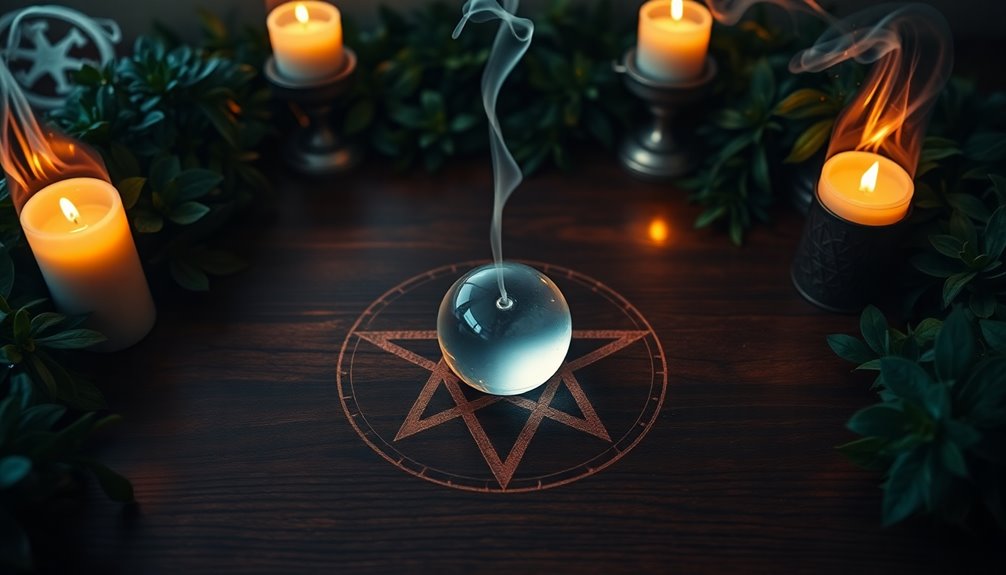
When you meditate with the pentagram, you can enhance your focus and intention by visualizing its shape, creating a powerful connection to the five elements.
Engaging in group meditation practices that incorporate the pentagram can deepen your experience, fostering a sense of community and shared energy.
This ritualistic approach not only aids your personal journey but also strengthens your bond with others on a similar path.
Meditative Visualization Techniques
The pentagram serves as a powerful symbol in meditative visualization techniques, inviting practitioners to explore its five points—earth, air, fire, water, and spirit. By focusing on each element, you create a deeper connection to nature and enhance your energy flow during meditation. You can trace the pentagram in the air with your finger or visualize it in your mind's eye, which helps foster concentration and a sense of protection.
Incorporating the pentacle, a pentagram within a circle, emphasizes grounding and unity among the elements. This ritualistic approach not only centers you but also highlights the cyclical nature of life. As you meditate, use the pentagram as a focal point for affirmations or intentions, channeling energy towards specific goals or desires.
The geometric properties of the pentagram contribute to a calming meditative space, where its symmetry promotes balance and tranquility. As you engage in these visualization techniques, you'll find that the pentagram not only serves as a tool for spiritual exploration but also enhances your overall meditative experience, bringing unity and harmony to your practice.
Community Group Meditation Practices
Community group meditation practices often harness the pentagram as a focal point, enhancing energy alignment and intention setting among participants. This sacred symbol represents harmony among the five elements: earth, air, fire, water, and spirit.
During meditation, you might draw or visualize a pentagram, deepening your connection to the natural world while invoking protective energies. This practice creates a sacred space where you and your community group can thrive.
The encircled form of the pentagram signifies unity and wholeness, allowing everyone to feel a collective purpose and shared energy.
Many modern spiritual groups, like Wiccan circles, incorporate the pentagram into their meditation practices, inviting in elemental forces that facilitate deeper spiritual experiences and personal transformation.
Symbolism in Popular Culture

Pentagrams have woven their way into popular culture, often embodying a blend of fascination and fear. Frequently depicted in horror films and literature, the pentagram serves as a symbol of witchcraft and the occult, often linked to black magic and satanic rituals. This association contributes to its negative connotations in mainstream media.
Inverted pentagrams, in particular, are widely used to signify evil or malevolent forces, reinforcing stereotypes around the symbol and its ties to satanism.
However, the pentagram's symbolism isn't solely negative. Many neopagan traditions reclaim it as a potent symbol of protection and elemental unity. This contrast showcases a more positive interpretation, diverging from its portrayal in popular culture.
You'll find the pentagram in graphic novels and music videos, emphasizing rebellion, mystery, and the supernatural, appealing to those drawn to the occult or alternative lifestyles.
Additionally, merchandise featuring the pentagram—like clothing, jewelry, and tattoos—has gained popularity among various subcultures. For many, it symbolizes personal beliefs in spirituality, magic, or individualism, showcasing the multifaceted nature of this powerful symbol in contemporary society.
Additional Resources

There are numerous resources available for those interested in delving deeper into the significance of the pentagram. You can explore academic works like Becker's *Pentagram* and Conway's *The Symmetries of Things*, which examine the pentagram's mathematical properties, including its relationship to the golden ratio. This geometric figure, often associated with the Greek word πεντάγραμμον, symbolizes the five elements of life and is a regular pentagon.
For visual learners, platforms like Wikimedia Commons offer a plethora of media files showcasing the pentagram in various contexts, from ancient usages to modern interpretations. MathWorld also features a detailed page that highlights the pentagram's mathematical significance.
If you're curious about the pentagram's cultural implications, literature and articles discussing its role as a Christian symbol and its adoption by groups like the Church of Satan can enhance your understanding.
Additionally, Biblioteca Arcana hosts resources on the Pythagorean Pentacle, which illustrates its historical ties to ancient Greek thought. These materials will help you appreciate the multifaceted meanings and usages of the pentagram across different belief systems.
Frequently Asked Questions
What Does the Pentagram Symbolize?
The pentagram symbolizes a range of ideas across different cultures.
You might see it representing the five elements—earth, air, fire, water, and spirit—in Wiccan beliefs.
If you explore Christianity, it can symbolize the five wounds of Jesus, offering protection and healing.
The ancient Greeks viewed it as a sign of health and harmony.
What Does the 5 Point Star Symbolize?
The five-point star symbolizes various concepts depending on cultural context.
You might see it representing the five elements: earth, air, fire, water, and spirit in spiritual practices.
In ancient Greece, it stood for health and harmony.
The upright version often signifies protection and balance, while the inverted form can imply material dominance over spirituality.
Its geometric beauty also reflects harmony in art and architecture, showcasing its significance beyond just a simple shape.
What Does the Pentagon Symbolize?
When you think about the pentagon, you might see it as a symbol of strength and stability. This five-sided figure often represents the five branches of the U.S. military, embodying national defense and unity.
In architecture, its geometric design reflects balance and harmony, making it a popular choice in various structures.
What Does the Star With a Circle Around It Mean?
When you see a star enclosed in a circle, it often symbolizes protection and unity.
You might recognize it as a powerful emblem in various spiritual traditions. The circle acts as a barrier, amplifying the energies and intentions within.
This star can represent balance among elements, emphasizing their interconnectedness.
It's not just a decoration; it's a reminder of harmony and wholeness, often used in rituals for safeguarding against negative influences.

